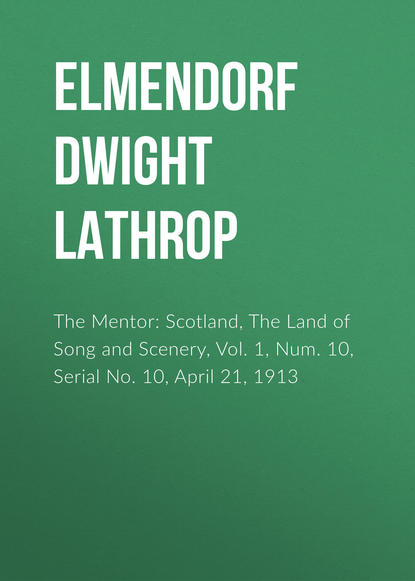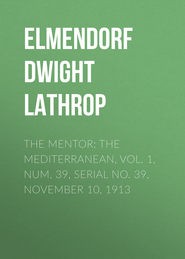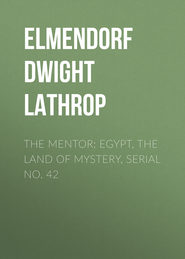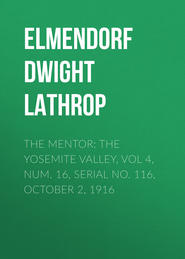По всем вопросам обращайтесь на: info@litportal.ru
(©) 2003-2024.
✖
The Mentor: Scotland, The Land of Song and Scenery, Vol. 1, Num. 10, Serial No. 10, April 21, 1913
Настройки чтения
Размер шрифта
Высота строк
Поля
The tragic story of the execution of Mary Stuart, who was crowned at Stirling, is one of the most pathetic episodes in history. Condemned on an unjust charge, she was sentenced to death by Elizabeth, queen of England. The final scene in the life of the beautiful queen of Scotland took place in Fotheringay Castle in England. As Mary approached the block, the melancholy sweetness of her beauty touched every heart. Even her executioners knelt and begged her to forgive them for the sad duty that they were forced to perform.
“I forgive you with all my heart,” sadly replied Mary.
She knelt down and laid her head upon the block amid a tense silence, broken only by an occasional sob. A moment later the chief executioner held up her head, exclaiming, “So perish all the enemies of Queen Elizabeth.”
SCOTLAND
Fingals Cave
SIX
Fingals Cave is a part of the Scotland end of the Giants Causeway, which was supposed to have once led from Ireland to the Isle of Staffa. They say that Fin MacCoul, or Fingal, as he is called, built the Giants Causeway. Fingal was an Irish giant – the champion hero of all the Emerald Isle. He wanted to fight Bennandonner, another giant, so he built the great causeway from Scotland to Ireland. It is written that Fingal won. In tradition he is the hero of both Ireland and Scotland.
Fingals Cave is the most famous of the many natural caverns on the Isle of Staffa, one of the western islands of Scotland. This island is three-quarters of a mile long, and about one-third of a mile wide. No one lives there; but every weekday during the summer a steamer takes tourists over to see the famous cave.
There are other caverns on Staffa; but Fingals Cave is the best known. Its columns are of basalt, and are six sided in shape. These columns are so regular that it seems hardly possible that the force of the waves alone could have formed them. But that is the fact; although not many years ago some one rushed into print to say that the ancient inhabitants of Scotland and the islands nearby had dug out all these caverns themselves. He even gave a lecture in New York City (charging a dollar a seat, the proceeds to go toward building a pedestal for the Statue of Liberty) to give his theories to the world. Unfortunately for him he did not know very much about geology, and could not prove his theories to be correct.
It was also stated by another theorist that the columns of the Giants Causeway were petrified growths of bamboo; but this idea too had only a short life.
Fingals Cave was discovered in 1772 by Sir Joseph Banks, who visited Staffa on his expedition to Iceland. The cave is on the southern face of the island. It is 66 feet high and at the entrance 42 feet broad. It runs back into the land a distance of 227 feet, and is only 2 feet wide at the end.
Seals and sea birds haunt the cave, and the murmur of the sea gave it the name in Gaelic of “The Cave of Music.” But when the weather is stormy the cave roars in anger. This is due to the air within being compressed by the waves, and then rushing out.
The Mentor
“A Wise and Faithful Guide and Friend”
Vol. 1
April 21, 1913
No. 10
SCOTLAND
THE LAND OF SONG AND SCENERY
A TRIP AROUND THE WORLD
With DWIGHT L. ELMENDORF
Lecturer and Traveler
ROBERT BURNS COTTAGE
ELLENS ISLE
MELROSE ABBEY
ABBOTSFORD
STIRLING CASTLE
FINGALS CAVE
In its contour and in its varied natural features Scotland is unique. It seems, indeed, as if Nature had shaped the land in a spirit of coquetry with the sea.
Though limited in territory, Scotland has a shore line thousands of miles in extent. Her coast is a series of inlets, firths, and sounds, and she has added to the irregularity of her shores by setting out innumerable beautiful islands that rear their rocky heads in the western sea. No one knows the full beauty of Scotland who has not visited the islands. Their picturesque and varied attractions pronounce them the true and natural offspring of the parent land.
Scotland has long been called the land of scenery and of song. The two are intimately associated. The scenery of Scotland has inspired many of her songs, and the songs have paid tribute in return by celebrating the beauty of the scenery in affectionate and eloquent phrase. The songs of Scotland breathe the life of the people and of the nation in a way that has won the sympathetic interest of the world. The prevailing note in Scottish song and literature is romance. The very name of Scotland is fragrant with romance. Its scenery is rich in romantic beauty and romantic associations, and its songs give eloquent expression to both.
And so the traveler in Scotland finds the charm of her scenery happily voiced for him, and as he wanders from one spot to another he can recall the lines that enhance its beauty. It may be “The Banks and Braes o’ Bonnie Doon” or “Within a Mile of Edinboro’ Town.” Wherever he goes he may enjoy the scenery in companionship with the spirit of the poet who sang its praises.
To most of us Scotland means Wallace and Robert Bruce in heroic chivalry, and Walter Scott and Robert Burns in romance and in song. Most of the scenes and places that interest the traveler are associated with one or another of these four names.
THE HOME OF BURNS
The name of Robert Burns has a hold upon the people of Scotland and on those who visit there such as finds no parallel in any other country. This makes a visit to the small town of Ayr an incident of prime interest to the tourist. The Robert Burns Cottage is situated about two miles from the town, and it is kept with reverent care as a memorial. The building itself, low-roofed and humble, with its Burns mementos, is a veritable shrine for lovers of the poet.
The chief feature of the quaint old house is the little, low-ceilinged room in which Burns was born in 1759. You will be glad to linger there awhile. The impressions of the room will remain in your memory for all time. As you note the humble simplicity of the scene you will get close to Burns, and you will feel the full meaning and appeal of his lines:
“Gie me a spark of Nature’s fire!
That’s a’ the learning I desire.
Then, tho’ I drudge thro’ dub an’ mire
At plow or cart,
My muse – tho’ hamely in attire —
May touch the heart!”
The whole country roundabout is full of Burns associations. A short distance off is Auld Alloway Kirk, where Burns’ father is buried, and where Tam o’ Shanter, overcome by the spirits that he imbibed too freely, was assailed and pursued by spirits ghostly. A short distance beyond the church are two bridges over the Doon, the old bridge being celebrated as the one over which Tam o’ Shanter made his escape from the evil spirits. In the garden near the bridges stands the formal but impressive Burns Monument.
Between that humble cottage down the road toward Ayr, and the Greek monument in the garden, is told the story of a simple, sweet, singing bard, whose lines so completely filled the hearts of his fellowmen that the very scenes of which he sang have become endeared to all humanity.
THE WALTER SCOTT COUNTRY
Between Loch Achray and Loch Katrine lies the Trossachs, beautiful in winding wooded roads and lake and mountain views – and famed chiefly for being Walter Scott’s own land of romance. It has often been said that one who has read Scott’s novels needs no guidebook in the Trossachs. Drive through this charming valley to Loch Katrine, a beautiful lake nearly ten miles long. From the east end steep cliffs ascend from the water’s edge, and there, looking through the brilliant foliage on the bank, you can see the pretty little Ellens Isle, made immortal in Walter Scott’s poem, “Lady of the Lake.” This is one of the most “pictured” spots in Scotland. You will find it in any illustrated volume of Scott’s poems. You will find it in color and in gravure, in large prints and on postcards, wherever you turn. It is the very heart of the Trossachs, and one of the most inviting spots in the British Isles – as attractive in its natural beauty as in the romantic associations that cast their spell about it.
MELROSE ABBEY
Hallowed by eight hundred years of history and immortalized by Walter Scott, Melrose Abbey stands today the most interesting, as well as the most beautiful, ruin in Scotland. It is the drawing attraction of the little town of Melrose, situated on the Tweed. Enticed by the magic of Scott’s lines, thousands visit the Abbey every year.
“If thou wouldst view fair Melrose aright,
Go visit it by the pale moonlight.”
So firmly have these verses stamped themselves on the hearts of readers all over the world that tourists feel that their visit is not complete unless they have seen the Abbey “by pale moonlight.” In response to this desire the Abbey is opened on moonlight nights for special visits.
Melrose Abbey was founded by David the First, in the twelfth century. After being destroyed by Edward the Second, it was rebuilt by Robert Bruce in the fourteenth century. It was again destroyed and rebuilt in the following century. During the many years of its history it suffered dreadfully from the ravages of war. Armies of invasion from England ruthlessly assaulted its sacred precincts and destroyed its beautiful features. In spite of that, after being reconstructed several times, it holds its place as a beautiful example of architecture and a most picturesque ruin.
THE HOME OF SCOTT











